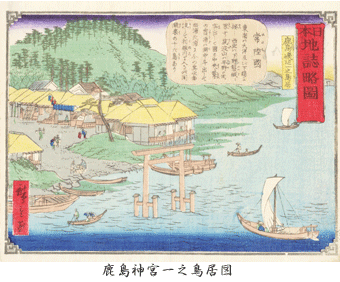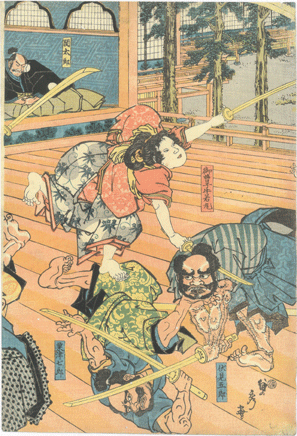|
Kashima-Shinryû (i.e., the "Kashima Spiritual Style") began in the Asuka Era (ca. 645) when Kuninazu no Mahito, a priestly celebrant of the Kashima Grand Shrine, attained a revelation from the August Deity of Kashima (Takemikazuchi no Mikoto). This revelation enabled him to transform "the Sword of Kashima" (Kashima no Tachi) from a religious ceremony that uses a sword for spiritual purification (harai tachi) into advanced techniques for human combat. The Kashima-Shinryû Menkyo Kaiden no Maki (scroll) handed down in the Shihanke Lineage (the oldest version of which dates to the hand of Kunii Taizen Minamoto no Ritsuzan, ca. 1780s) describes this crucial event in the history of Japanese warrior arts as follows: "Kashima-Shinryû begins with the ancient traditions of 'the Sword of Kashima' (Kashima no Tachi) at the Kashima Jingû Grand Shrine. One thousand two hundred years ago Kuninazu no Mahito, a priestly celebrant at the shrine, devised these sword techniques and taught them to the world..." The book Tôgoku Meisho Zue: Kashima Shi (Gazetteer of Kashima, the Renown Shrine in Eastern Japan), written in 1833 by a celebrant at the Kashima Grand Shrine named HÔJÔ Tokichika (1802-1877), provides strong historical evidence for the existence of this tradition. It explains that the "Futsu no Mitama no Kata" (i.e., the revelation received by Kuninazu no Mahito) consist of what is more commonly known as "Shinmyôken no Kata": divinely-inspired marvelous fencing technique. The precise details of this art have been taught exclusively within the orthodox main lineage of the Kashima Spiritual Transmission (Kashima Shinden; regarding which, see: TÔ Minoru, Kashima Jingû, Gakuseisha, 1968). Therein it constitutes the highest level of secret initiation. For this reason, written accounts of this teaching, such as those that appear in our martial art scrolls and other initiation documents, cannot be deciphered or understood by martial artists of other traditions. They are comprehended only by the most advanced students in the orthodox main lineage who have been admitted to the level of Menkyo Kaiden (i.e., full initiation). The transmission of martial art teachings regarding these kinds of secret ultimates (gokui) succeeds only when the lineage continues without interruption and when the headmasters of each successive new generation persevere month after month and year after year in the intense training necessary to acquire what can be taught only "from hand to hand" (as practical techniques) and "from mouth to mouth" (as theoretical principles). Otherwise the spiritual essence will be lost.
|
|
During the later half of the sixteenth century the Kashima-Shinryû took shape as a formal lineage through the efforts of an officer of the Kashima Grand Shrine who was known as MATSUMOTO Bizen-no-kami Ki no Masamoto. Matsumoto's attempts to develop Shinbu (Divine Martiality) were assisted by Kunii Genpachirô Minamoto no Kagetsugu. At that time Kagetsugu was the head of the Kunii branch of the Minamoto clan of Hitachi. Several generations of his ancestors had ruled the territory of the Kashima Grand Shrine. They thereby learned the "Futsu no Mitama no Kata" from the priests of the shrine and incorporated it into their family lore. Matsumoto disciplined himself intensely at the Kashima Grand Shrine, seeking divine inspiration day after day. Eventually he formulated Kashima-Shinryû as a system of warrior arts crowned by the seemingly invincible technique of Ichi-no-Tachi (the Foremost Sword). The Kunii-ke Sôden Kashima-Shinryû Hyôhô Denki (Biographical Records of Kashima-Shinryû Warrior Arts Traditionally Handed Down in the Kunii Family) describes this process as follows:
|

The Ichi-no-Torii (outermost gateway) of the Kashima Jingû Grand Shrine
|
|
Generation 1
The founder of Kashima-Shinryû is MATSUMOTO Bizen-no-kami Ki no Masamoto. While residing in the province of Hitachi, morning and evening he offered prayers in the august presence of Kashima so that he might conform to the divine will. One evening in a dream he was given a single scroll, the same scroll once dedicated to the Kashima Deity by [MINAMOTO] Genkurô Yoshitsune. Because it constitutes a proper spiritual transmission (shinden), he called this style Shinkageryû (i.e., the "Divine Shadow" or "Divine Grace" Style).
KUNII Kagetsugu of the Minamoto clan of Hitachi provided empirical aid [in understanding the spiritual transmission] and thereby played a major role.
|
Thus, Kashima-Shinryû records refer to Matsumoto Bizen-no-kami as the first generation of the Shihanke (lineage of headmasters) and to Kunii Kagetsugu as the first generation of the Sôke (lineage of the founding house). These two lineages developed independently for 10 more generations until the 12th-generation Shihanke, KUNII Taizen, inherited both lines.
The Shihanke lineage includes such notable warriors as: (2) KAMIIZUMI Ise-no-kami Fujiwara no Hidetsuna, who became renowned as the founder of the Shinkageryû; (3) OKUYAMA Kyûgasai Taira no Kimishige, who taught fencing to TOKUGAWA Ieyasu (the future shogun); and (4) OGASAWARA Genshinsai Minamoto no Nagaharu, who traveled to China and subsequently introduced elements of Chinese martial arts (i.e., gongfu or kung fu in a wide sense) into Kashima-Shinryû.
|

Detail of the woodblock print titled "Kiichi Hôgen Kenjutsu Keiko no Zu" (Fencing Instruction by Dharma Master Kiichi) by GYOKURANSAI Sadahide (1807-1878?). This section depicts "Onzôshi Ushiwakamaru" (i.e., MINAMOTO-no-Yoshitsune as a youth).
According to the traditions of the Kashima Jingû Grand Shrine, the "the same scroll once dedicated to the Kashima Deity by Genkurô Yoshitsune" mentioned in the Kunii-ke Sôden Kashima-Shinryû Hyôhô Denki refers to: "the Rikutô Sanryaku of Taigong Wang. Dharma Master Kiichi transmitted these scrolls to MINAMOTO-no-Yoshitsune (a.k.a. Ushiwakamaru) and he donated them to the Shrine" (TÔ Minoru, Kashima Jingû, Gakuseisha, 1968, p. 181). Note: The names Rikutô (Liutao) and Sanryaku (Sanlüe) are titles of actual military treatises written by Taigong Wang (a.k.a. Lu Shang) but in popular usage the compound noun Rikutô Sanryaku refers to any texts that convey superlative military teachings.
|
The Sôke lineage continued through the Kunii family. During the Tokugawa period (1603-1867) they established a martial academy (dôjô) in Funao Village, Iwasaki District, Banshû Province (now part of Jôban Yumotomachi, Iwaki City, Fukushima Prefecture). In Funao they maintained their own family tradition (kaden) of martial lore while also privately offering practical martial training to disgruntled rônin (masterless samurai) and gôshi (rural samurai) from across the provinces of Iwaki and Hitachi (modern Fukushima and Ibaraki Prefectures) as a way of nurturing anti-Tokugawa sentiments. Many warrior families in these regions, including the Kunii, had suffered suppression at the hands of the Tokugawa regime and anticipated better times through its demise. (For example, when the Tokugawa forced the warrior leader SATAKE Yoshinobu [1570-1633] to relocated from his domain in Hitachi to one of less than half the size in Akita province, many of the warriors who had served under Satake had to remain behind and their descendants still exist in great numbers across northern Ibaraki prefecture.)
Each generation of the Kunii upheld this martial tradition of combined family lore and private instruction throughout the Tokugawa period. They became particularly active after the 1790s when MATSUDAIRA Sadanobu (1759-1829) promulgated new government policies to revitalize martial training in Japan. Thereafter the Kunii family provided instruction to warriors who held formal affiliation to many different groups. They taught warriors from the Mito Domain (in Ibaraki Prefecture; where various lines of Shinkageryû and Kashima-Shintôryû and Igaryû flourished), samurai stationed in Edo (especially ones from the Numata Domain, the home of the main line of the Jikishinkageryû, as well as ones from the domains of Tsuchiura, Tanaka, Iyo Matsuyama, etc., where branch lines of Jikishinkageryû existed) and even HIRAYAMA Kôzô (a secret agent for the Tokugawa shogun who subsequently developed his own style of martial arts called the "Jitsuyôryû" or "Effective Methods"). During the Showa period (1926-1988) the 18th-generation Shihanke, KUNII Zen'ya (1894-1966), was especially noteworthy for his exhaustive testing and reinvigoration of each pattern (kata), for his military exploits, and for his tireless efforts to revive martial arts in Japan after the Second World War. He entrusted Kashima-Shinryû to SEKI Humitake, the current 19th-generation Shihanke.
|
|
In thus manner each generation of the lineage has refined Kashima-Shinryû while preserving its essential core as a koryû bujutsu (an old-school-style martial system). The paramount teachings (ôgi) of Kashima-Shinryû can be summarized as: "First condition the body, then cultivate one's spirit and one's humanity, and ultimately attain an understanding of the creative phenomena of the universe." The 19th-generation Shihanke established the Kashima-Shinryû Federation of Martial Arts and Sciences to facilitate the proper teaching of these paramount teachings within modern society. Toward these ends the Federation authorizes chapters and satellite chapters at high schools, colleges, and other public institutions in Japan and abroad. These chapters provide comprehensive instruction in the principles and theory of traditional Japanese Budo (Military Ways) and practical training in jujutsu (unarmed techniques), kenjutsu (swordsmanship), battôjutsu (fencing with actual swords), pole arms, and other advanced arts.
|


